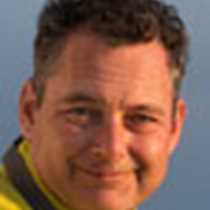Early in the morning, well before sunrise, the National Geographic Sea Lion sailed along the northern coast of Chichagof Island in an ethereal landscape. Low clouds and fog patches partially covered the mountains and small islands around us and only the occasional harbor porpoise or sea otter broke the calm surface of the water.
A light drizzle didn’t stop us from going ashore at Port Althorp, where we arrived just before breakfast. The protected cove offered perfect conditions for kayaking and hiking, and we took full advantage of that. There are no human trails in Port Althorp but no shortage of bear ones! We explored the mudflats exposed at low tide and, in the meadows, we found an abundance of Sitka black-tailed deer and brown bear footprints. Lots of them! And big!
With long claws clearly marked, those impressive paw prints made us redouble our precautions as we approached the stream at the end. Some of us saw one lone bear but only very briefly. Bears are not accustomed to seeing people in this remote area, but we did see plenty of evidence of their presence. The stream was full of pink or humpback salmon, locally known as “humpies,” and we had a wonderful time watching the fish return to the areas where they hatched a couple of years before.
After returning to our floating home for lunch, we headed to our afternoon destination: The Inian islands. The Inians form a small archipelago located between the large Chichagof Island and the southern portion of the mainland’s Fairweather range, which partially obstructs the flow of water between the Gulf of Alaska and the northern part of the Inside Passage. The resulting speeding-up of the tidal currents as they flow through the Inians brings an abundance of nutrients and the fish that make Alaska famous.
Exploring the area in our inflatable expedition craft, we delighted in watching numerous sea otters, Steller’s sea lions, harbor porpoises, bald eagles and even a couple of humpback whales. Steller’s sea lions were particularly conspicuous for their huge size and their large numbers. Resting on shore or swimming around us, their constant roaring filled the air and added a note of excitement and wildness to the already wild landscape. It was a great finale to another beautiful day in Southeast Alaska.









